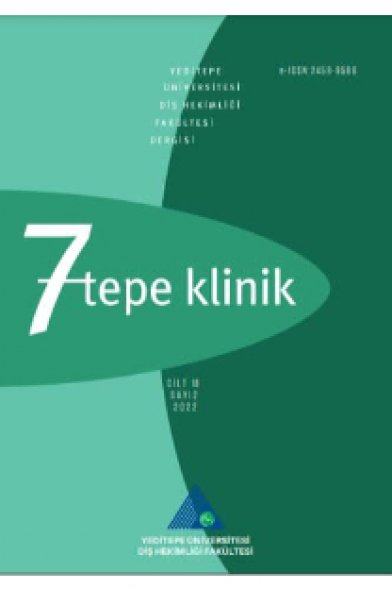Prevalence of fossa navicularis among cleft palate patients detected by cone beam computed tomography
Damak yarığı hastalarında fossa navicularis görülme sıklığının konik ışınlı bilgisayarlı tomografi ile değerlendirilmesi
___
- Kuijpers MA, Pazera A, Admiraal RJ, Bergé SJ, Vissink A, Pazera P. Incidental findings on cone beam computed to- mography scans in cleft lip and palate patients. Clin Oral Investig 2014; 18: 1237-1244.
- Beltramello A, Puppini G, El-Dalati G, et al. Fossa navicu- laris magna. Am J Neuroradiol 1998; 19: 1796-1798.
- Ersan N. Prevalence and Morphometric Features of Fos- sa Navicularis on Cone Beam Computed Tomography in Turkish Population. Folia Morphol. (Article in press.)
- Cankal F, Ugur HC, Tekdemir I, Elhan A, Karahan T, Se- vim A. Fossa navicularis: anatomic variation at the skull base. Clin Anat 2004; 17: 118-122.
- Ray B, Kalthur SG, Kumar B, et al. Morphological varia- tions in the basioccipital region of the South Indian skull. NJMS 2014; 3: 124-128.
- Rizzo A. Canale cranio faringeo, fossetta faringea, in- terparietali e preinterparietali nel cranio umano. Monogr Zool Ital 1901; 12: 241-252.
- Romiti G. La fossetta faringea nell'osso occipitale dell'uomo. AttiSoc Toscana Sci Nat 1890; 11.
- Sekhon PS, Ethunandan M, Markus AF, Krishnan G, Rao CB. Congenital anomalies associated with cleft lip and palate-an analysis of 1623 consecutive patients. Cleft Palate Craniofac J 2011; 48: 371-378.
- Currarino G. Canalis basilaris medianus and related de- fects of the basiocciput. Am J Neuroradiol 1988; 9: 208
- Prabhu SP, Zinkus T, Cheng AG, et al. Clival osteomy- elitis resulting from spread of infection through the fos- sa navicularis magna in a child. Pediatr Radiol 2009; 39: 998.
- Segal N, Atamne E, Shelef I, Zamir S, Landau D.. Intra- cranial infection caused by spreading through the fossa naviclaris magna - a case report and review of the litera- ture. Int J Pediatr Otorhinolaryngol 2013; 77: 1919-1921.
- ISSN: 2458-9586
- Yayın Aralığı: 3
- Başlangıç: 2005
- Yayıncı: Yeditepe Üniversitesi Rektörlüğü
Ponticulus posticus: is it important for a dentist as a radiological finding?
Şeyma ALLA, Selim Aydın GÜMÜŞDAL, EROL CANSIZ, Mehmet Ali ERDEM, Sabri Cemil İŞLER
İbrahim ŞİMŞEK, Buket AYNA, ERSİN UYSAL
GÖKHAN GÜRLER, EMRAH DİLAVER, Erkan SOYLU, Tuba DEVELİ, BARIŞ ÇAĞRI DELİLBAŞI
Using different anaesthesia techniques during arthrocentesis: case series
YUSUF EMES, Itır Şebnem BİLİCİ, Buket AYBAR, Uğur AGA, Melike SÜBAY ORDULU, HALİM İŞSEVER, Serhat YALÇIN, Anıl CESUR
İki farklı bonding sisteminin erozyonlu mine dokusunda bağlanma dayanımlarının karşılaştırılması
Alican PAMAY, Mete BUYUKERTAN, HÜSEYİN AVNİ BALCIOĞLU
Temporomandibular eklem bozuklukları ve teşhisi
MEHMET YALTIRIK, Alen PALANCIOĞLU, MELTEM KORAY, Cevat Tuğrul TURGUT
